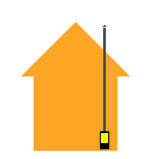Chimney fires and their causes
If your chimney is not kept clean then flammable deposits can build up to the level where they can ignite. Obviously not sweeping your chimney regularly is one cause, but you also increase the level of deposits if you slow burn your stove, if you "turn it down for the night" or if you burn wet wood. Once alight the fire then spreads up the chimney, and it can get very hot, over 1000 C.
How to tell if you have a chimney fire - You will often hear a roaring noise in the chimney, especially with an open fire. Outside masses of smoke will be pouring out of the chimney.
When you start to see flames coming out of the chimney you know that the chimney fire is near it's end.
What to do if you have a chimney fire
- Call the fire brigade - 999
- If you have a stove then shut all air vents and flue dampers to reduce the chimney fire's oxygen supply
- If you have an open fire then gently splash water on it to extinguish the fire.
- Move flammable materials, furniture, ornaments away from the fireplace
- If you have an open fire then (as long as there is no risk to you) block the fireplace opening with something noncombustible
- Feel the chimney breast throughout the house - if it is getting hot then move furniture away from it
- Do not pour water on the fire if you have a stove
- Do not pour salt on the fire - this can create chlorine gas which is damaging to the chimney and toxic if it gets into the room
- Ensure that the fire brigade can access the loft space
- In severe cases where there is deemed to be a risk of the fire spreading to the roof use a hose to wet down the roof near the chimney but not the chimney itself
We had this page checked over by Avon Fire Brigade - our thanks!
Damage caused by chimney fires
Coal soot chimney fires can create temperatures up to 1000 degrees centrigrade inside the chimney.
Wood tar chimney fires can create temperatures up to 1200 degrees centrigrade inside the chimney.
Clay liners - a chimney fire will often cause clay liners to crack and therefore the chimney will probably need to be relined (you may be able to claim for this under your household fire insurance). Contact us for advice.
As the chimney heats up during the chimney fire it expands - this causes plasterwork to crack and even blow off and can cause structural damage to the chimney.
On one chimney fire job I looked at the headboard of the bed that was against the chimney breast was scorched and the plaster looked like a London Underground map. On another job there had been a wood tar fire to the stone-built chimney. The stones inside the chimney had a glassy sheen as they had been vitrified by the high temperature inside the chimney!
Worst case scenario chimney fires
Chimney deposits are intumescent and expand when heated. In the worst case scenario they can expand to the extent that they block the chimney. The chimney fire will then seek oxygen from the nearest available source - usually the stove or fireplace - which means that the fire can come out of the bottom of the chimney.
In extreme cases where the integrity of the top of the chimney is already compromised the top courses of brick can blow off due to the pressures inside the blocked chimney.
Heat from the chimney fire can transfer into joists and weaken them through smoldering and cause them to catch fire. Sparks and debris flying out of the chimney can also set fire to the roof if there are tiles missing.



